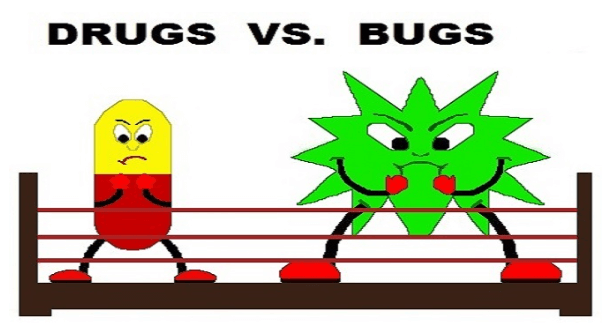Hi! My name is Tim (@IDstewardship, http://bit.ly/TimothyGauthier) and I am a pharmacist with advanced training in the field of infectious diseases & antimicrobial stewardship. Eric (@Mededucation101) was nice enough to ask me to contribute to his blog! My primary objective is that you find my contributions to be valuable to your continued education as a healthcare professional, let’s hope it hits the mark!
One of my biggest pet peeves is when a clinician has misconceptions about the coverage for a given antimicrobial agent. Accidentally believing a drug has coverage or clinical utility versus a given bug/ infection, when it does not, can have devastating consequences for the patient. Alternately, employing therapies that are unnecessarily broad spectrum in their microbial activity can be significantly detrimental to the patient (eg, result in Clostridium difficile infection). Here are some quick “bugs and drugs” references to reinforce what you may have forgotten, but note this is not an exhaustive list and depending on the infection type, may not be applicable (eg, daptomycin has no role in the treatment of pneumonia, but does cover MRSA).
| See | Think | DO NOT Think |
| Methicillin-sensitive Staphylococcus aureus (MSSA) | Oxacillin, nafcillin, dicloxacillin, cloxacillin, amoxicillin-clavulanic acid, cefazolin or cephalexin | Amoxicillin, ampicillin, ceftriaxone or vancomycin |
| Methicillin-resistant Staphylococcus aureus (MRSA) | Sulfamethoxazole-trimethoprim doxycycline, tigecycline, clindamycin, vancomycin, daptomycin, telavancin, dalbavancin, oritavancin, ceftaroline, linezolid, tedizolid or quinupristin/dalfopristin | Ceftriaxone, piperacillin-tazobactam, cefepime, carbapenems or fluoroquinolones |
| Pan-sensitive Enterococci | Ampicillin or amoxicillin | Vancomycin |
| Ampicillin-resistant Enterococci | Vancomycin | – |
| Vancomycin-resistant Enterococci (VRE) | Daptomycin, linezolid or tigecycline | Vancomycin |
| Beta-haemolytic Streptococi | Penicillin | – |
| Alpha-haemolytic Streptococci | Ceftriaxone, levofloxacin, amoxicillin-clavulanic acid [beware penicillin & azithromycin resistance] | – |
| Pseudomonas aeruginosa | Piperacillin-tazobactam, ceftazidime, cefepime, ceftazidime-avibactam, ceftolozane-tazobactam, meropenem, doripenem, imipenem-cilastatin, aztreonam, ciprofloxacin, levofloxacin, amikacin, gentamicin, tobramicin, polymyxin E (colistin), polymyxin B | Tigecycline, ertapenem or moxifloxacin |
| Stenotrophomonas maltophilia | Sulfamethoxazole-trimethoprim or levofloxacin | Carbapenems |
| Anaerobes | Metronidazole, clindamycin, ampicillin-sulbactam, amoxicillin-clavulanic acid, piperacillin-tazobactam, cefoxitin, cefotetan, moxifloxacin or tigecycline | Cefazolin, ceftriaxone or cefepime |
| Clostridium difficile | Metronidazole, oral or rectal vancomycin, or fidaxomicin | Intravenous vancomycin |
| Atypical organisms | Macrolides or fluoroquinolones | – |
| Candida albicans | Fluconazole | Echinocandins or amphotericin B |
| Candida krusei | Echinocandin | Fluconazole |
| Cryptococcus neoformans | Amphotericin B, fluconazole | – |
| Aspergillus sp. | Voriconazole | – |
The views expressed in this article are those of the authors and do not necessarily reflect the position or policy of the Department of Veterans Affairs or the United States government.
Timothy Gauthier PharmD, BCPS, AQ-ID
Looking for more pearls? Get 30 medication mistakes every healthcare professional should know!



Thank you for takin time and providing the list above…I’m going to ID rotation next and this will help me a lot to prepare myself.
Would like to see me content on ID, basic..advanced…with pearls!!
I found your post very pertinent to my practice and hope you will continue to share your expertise with us! Thank you.
Thank you. Where else can we look up reference? Good pocket reference you recommend?
Stanford antimicrobial guide. It’s updated every year. I highly recommend it.
nice chart, thanks for sharing where were you with your chart 8-9 years ago 😉 funny I just had a chat with 2 patients about the choice of antibiotic they were given and had to encourage them to go back in or call when their symptoms weren’t subsiding. I’ve seen a lot of inappropriate prescribing lately.
Thank you, this is most useful 🙂
Can we add Ampicillin/amoxicillin to the VRE section (when sensitive)?
Awesome chart. Makes it easy to remember the drug bug combo’s. Thanks for sharing.
Just one second look in to the chart the prescriber can find out what antibiotic he can use to treat the patient
Valuable chart .
Thank you for sharing! An invaluable resource for practitioners! I just signed up for your blog!
A useful summary! Thanks for sharing.
Great chart! Any suggestions on where to find a good succinct chart on which bugs are typically implicated in specific infections? Particularly with regard to outpatient pharmacy?
hmmm…don’t have a good answer for you on that one without some research! Maybe one of my followers would have a good link? Thanks for the question!
Although not in chart form, this link is fairly extensive on the common causes of infectious diseases. I found it very helpful.
https://www.atsu.edu/faculty/chamberlain/Website/common.htm
GlobalRPh.com has an Infectious Disease section that shows what bugs commonly cause specific infections.
Hi, I downloaded your bug and drugs cheat sheet (updated Oct 2018). I noticed on the right side, it says “see this…think not for…” I see that linezolid says it’s not for MRSA bacteremia. I did a quick search, and I am not familiar with the reasoning behind this? Can someone shed any light?